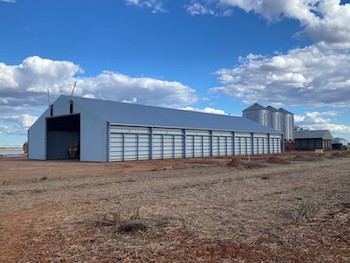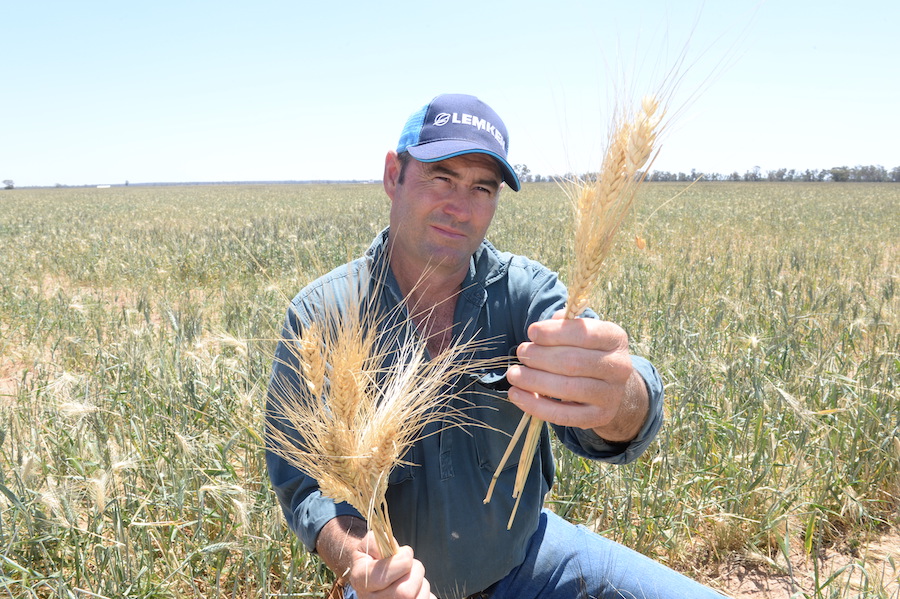Snapshot
Owners: Paul and Meggan Adam, parents Russell and Deidre Adam, son Robert
Manager: Paul Adam
Location: Tottenham, central western NSW (180 kilometres west of Dubbo)
Property names: ‘Dysart’ and ‘Lansdale’ (mix of owned and leased land)
Area cropped: 2000 hectares
Average annual rainfall: 450 millimetres
Soil type: red clay loam
System: continuous cropping, no fallow
Crops: bread wheat, canola, durum wheat, occasional chickpeas
Ten years can be a long time in farming – long enough for a grower to see the practical and commercial impact of gradual changes in thinking, systems and management practices.
Tottenham, New South Wales, grain grower Paul Adam says he was perhaps too rigid in his focus a decade ago, when his farming emphasis was all about cutting costs and no-till sustainable agriculture that rarely let a plough disturb the fragile topsoils on his 2000 hectares of dryland cropping country 180 kilometres west of Dubbo.
With an average annual rainfall of just 450 millimetres, preserving soil moisture and keeping input costs to a minimum was paramount in the pursuit of greater cost efficiencies per hectare of crops sown.
It was a principle Paul relentlessly followed, combining no-till with controlled traffic management to reduce costs and boost sustainability and profit margins in his continuous cereal rotation.
But Paul admits that even back in 2011, he was troubled about where the next big crop yield leap and productivity gains were going to come from, as rising costs continued to erode profit margins.
In 2011, as a bright young 34-year-old, he looked to the world for answers. He used a Nuffield Scholarship to investigate cost efficiencies and advances in no-till cropping systems and machinery around the globe, including the US, the UK, Germany, the Netherlands, Canada and Brazil.
“I was looking for the next big thing that was going to deliver productivity gains and drive down input costs. I wanted to know ‘what comes next?’,” he recalls with a wry laugh.
“But at the end I realised there was no silver bullet – there wasn’t going to be a new variety of genetically modified crop, or a new bit of machinery, or even a new chemical that was going to be the answer.
“I also realised two other things: that Australian farmers are already among the most efficient in the world and that – both here and globally – we as growers had done all the easy big things to cut costs and achieve greater productivity and that, from here on, it was going to be about achieving the one per cent and two per cent gains .”
 Greater on-farm grain storage capacity is a new priority for NSW grower Paul Adam. Photo: Courtesy Paul Adam
Greater on-farm grain storage capacity is a new priority for NSW grower Paul Adam. Photo: Courtesy Paul Adam
Now, in 2022, after bringing in late and rain-affected canola, durum wheat and premium (flour) wheat, Paul admits to being a little older, wiser and less rigidly idealistic than his younger self.
“Looking back, going on the Nuffield Scholarship helped me appreciate this. I was too focused on cutting every cost I could, which made me too conservative in our business,” he says.
“I was too cost-conscious and too conservative, which meant I sacrificed some yield potential in the better years and missed out on some opportunities (for bigger profits) as a result.”
Now at the two farms he runs, ‘Dysart’ and ‘Lansdale’, he has considerably adjusted his farming systems and thinking since 2011.
Hard durum wheat, soft wheat and canola are continuously cropped on his 2000ha of reliable red clay loam country, without any fallow periods.
Legumes are not consistently used as break crops to return nitrogen to the soil, as Paul has found – despite numerous experiments with faba beans, lentils, lupins, chickpeas and field peas – that their marketability and prices do not make them profitable enough.
Instead, ample nitrogen in the form of urea and liquid ‘Van’ nitrate fertiliser is brought onto the farm to replenish soils. Glyphosate is sprayed to control weeds before the new seed is direct-drilled into retained stubble.
He now sees no-till as being only part of the picture: “Sustainability is important but storing maximum moisture and the timeliness of getting everything right is my top priority now,” says Paul, 45.
“We are using much more fertiliser than we were – we are less conservative about that too – because I look back and see that we were capping our yields by farming too much for the drought years rather than the better seasons.
“Now I focus more on the financial outcomes of my business and getting the best yields, margins and returns I can, rather than on cutting costs all the time and always retaining my stubble.”
This more-flexible approach is already paying dividends.
This past cool and wet harvest season, with its 189mm of November rain, delivered the best crop yields ever for the Adam family. The bumper result came despite the canola harvest being halted midstream in November by waterlogged paddocks and flooding and the headers still working on the wheat, durum and canola crops late into January.
Central western NSW grower Paul Adam. Photo: Rachael Webb, The Land
It saw wheat achieve an average four tonnes/ha – a record in this dry, almost marginal, cropping zone, with his LRPB Kittyhawk dual-purpose wheat crop winning him a local yield competition.
Another good year looms for the approaching 2022 season, with half the needed soil moisture already stored after receiving 668mm of rain in 2021.
Paul’s durum wheat (Westcourt ), which is sold to Italy for pasta manufacture, captured a premium $700/t at port, nearly double the price of the bread (soft) wheat he harvested.
Even his flood-affected canola, which is sold to the MSM mill at Manildra, south of Dubbo, for oil, yielded 1.7 to 1.8t/ha and is returning $870/t this year.
“It was an exceptional, and unusual, season, even with the rain and floods. We’ve now had two absolute crackers back-to-back.
“But you have to remember we had three bad years in a row back in 2017, 2018 and 2019, and a couple of shockers in the decade before that, so the trick lies in learning to farm to all those conditions if you are going to crop continuously.”
Versatile system
In the lower-rainfall years, he says, the strength of his adjusted cropping system shone through. With the focus on storing as much soil moisture as possible – and stopping weeds using it – he now has a system that performs well in both dry and wet years.
This has meant a change in his attitude to soil disturbance. While crop stubble is usually retained and direct-drilling still used, flexibility is key, along with a firm eye on always maximising each season’s yield potential. Ploughing, tilling and ripping are no longer dirty words.
“Our usual program is to retain stubble, but this year we will have to work up and level some of the paddocks where the floods went across.
“In the past three to four years, we have actually deep-ripped the whole farm, to get rid of old, hard subsurface plough pans that had formed and to crack open the soil profile, so we can store even more moisture.
“The difference this has made was very clear at harvest time after the wet spring last year. Many locals were back harvesting straight after the rain while we couldn’t even turn a wheel in any paddock because they were so wet.
“But it’s hard to complain when our whole strategy is aiming for maximum moisture and soil holding capacity. It is exactly what we wanted to achieve in the long term and it is already being rewarded in yield. We are making more money and it’s not by cutting costs.”
The more organised you are, the easier it is, especially now with COVID-19 and global supply chain disruptions. You’ve also got to be prepared to buy big in bulk, but the savings are there to be made.
Other changed priorities for Paul in the past decade have been a renewed focus on the business’s logistics, including marketing.
He prefers to sell his grain direct to end users. A large quantity of grain is stored on-farm in grain bags, allowing the family to take advantage of frequently higher prices later in the year. A new grain shed is also being built on the farm, boosting storage to 4000t, equivalent to an annual average harvest.
He is also committed to buying most of his farm inputs well ahead of the season, by buying direct from suppliers. He already has all the fertiliser, urea, seed and agricultural chemicals needed for the approaching 2022 season.
“There is easy money to be made in logistics – by having long-term relationships and doing it yourself, rather than buying and selling through agents and middle men.
“The more organised you are, the easier it is, especially now with COVID-19 and global supply chain disruptions. You’ve also got to be prepared to buy big in bulk, but the savings are there to be made.
“A perfect example is how we bought large amounts of glyphosate in 2020 at $3.80/litre and now it is costing $14/litre because of China shutdowns, COVID-19 and transport issues. The same goes for urea.”
The bumper yields and returns of the past two seasons at ‘Dysart’ have also seen some key new business investments made. Besides the new grain storage shed, a new header with its own grain analyser built in was bought in 2020 and a self-propelled spray rig purchased in 2021.
While precision agriculture and variable-rate technology are not a key driver yet, Paul knows he has 10 years of data already collected by his equipment for when he wants to make more use of it.
“Our mobile phone coverage – and even our landlines – are not good and reliable enough yet to make the best use of all that data. It’s immensely frustrating, so my focus with machinery and inputs is on efficiency and timeliness of sowing and spraying. This is critical to final yields.”


























































